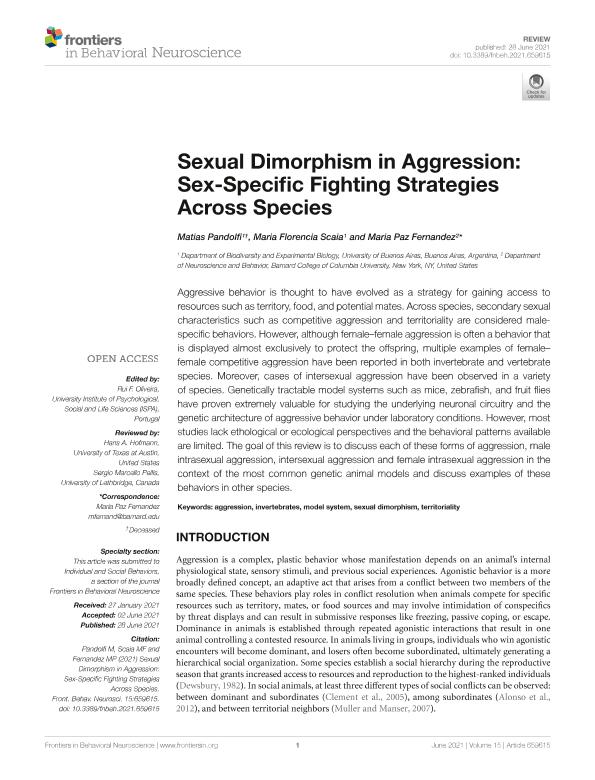Artículo
Sexual Dimorphism in Aggression: Sex-Specific Fighting Strategies Across Species
Fecha de publicación:
06/2021
Editorial:
Frontiers Media
Revista:
Frontiers in Behavioral Neuroscience
e-ISSN:
1662-5153
Idioma:
Inglés
Tipo de recurso:
Artículo publicado
Clasificación temática:
Resumen
Aggressive behavior is thought to have evolved as a strategy for gaining access to resources such as territory, food, and potential mates. Across species, secondary sexual characteristics such as competitive aggression and territoriality are considered male-specific behaviors. However, although female–female aggression is often a behavior that is displayed almost exclusively to protect the offspring, multiple examples of female–female competitive aggression have been reported in both invertebrate and vertebrate species. Moreover, cases of intersexual aggression have been observed in a variety of species. Genetically tractable model systems such as mice, zebrafish, and fruit flies have proven extremely valuable for studying the underlying neuronal circuitry and the genetic architecture of aggressive behavior under laboratory conditions. However, most studies lack ethological or ecological perspectives and the behavioral patterns available are limited. The goal of this review is to discuss each of these forms of aggression, male intrasexual aggression, intersexual aggression and female intrasexual aggression in the context of the most common genetic animal models and discuss examples of these behaviors in other species.
Palabras clave:
AGGRESSION
,
INVERTEBRATES
,
MODEL SYSTEM
,
SEXUAL DIMORPHISM
,
TERRITORIALITY
Archivos asociados
Licencia
Identificadores
Colecciones
Articulos(IBBEA)
Articulos de INSTITUTO DE BIODIVERSIDAD Y BIOLOGIA EXPERIMENTAL Y APLICADA
Articulos de INSTITUTO DE BIODIVERSIDAD Y BIOLOGIA EXPERIMENTAL Y APLICADA
Citación
Pandolfi, Matias; Scaia, María Florencia; Fernandez, Maria Paz; Sexual Dimorphism in Aggression: Sex-Specific Fighting Strategies Across Species; Frontiers Media; Frontiers in Behavioral Neuroscience; 15; 6-2021; 1-12
Compartir
Altmétricas




